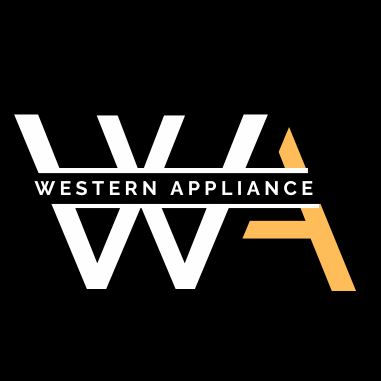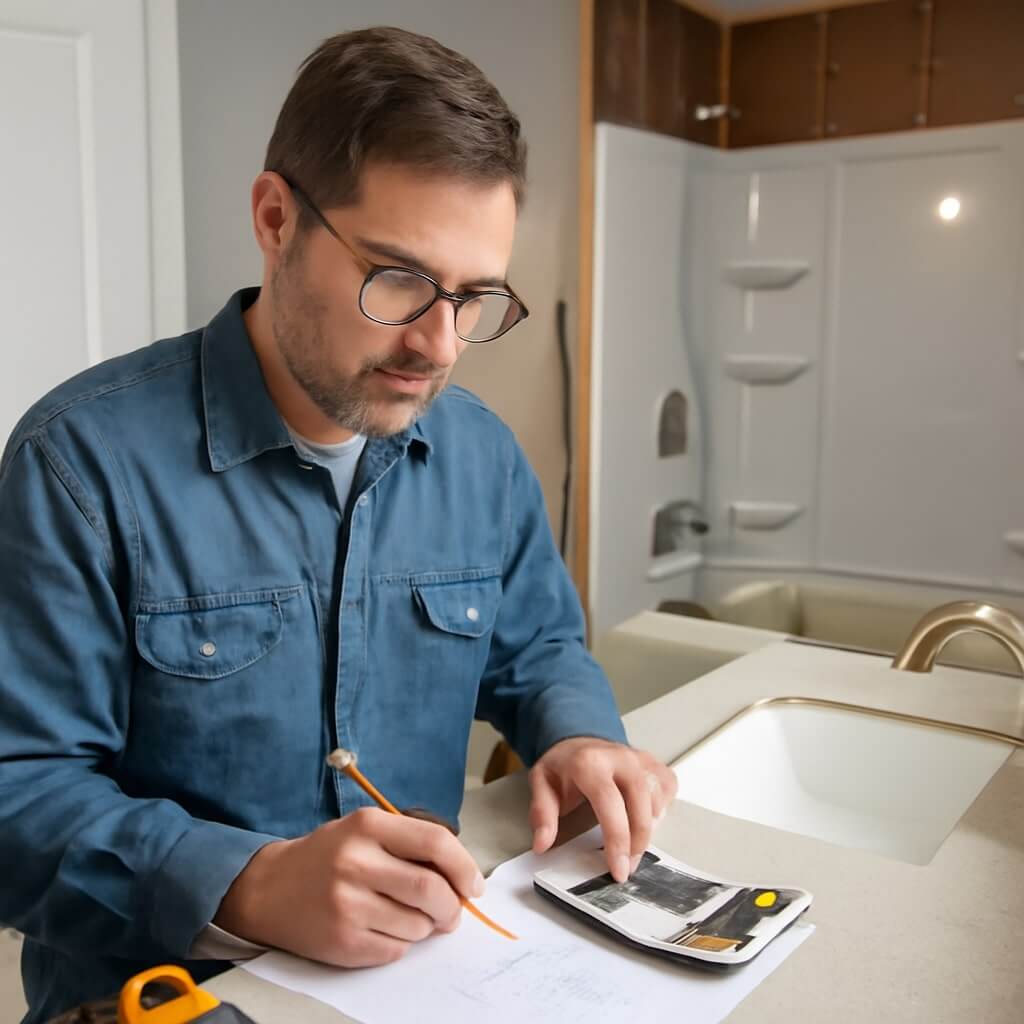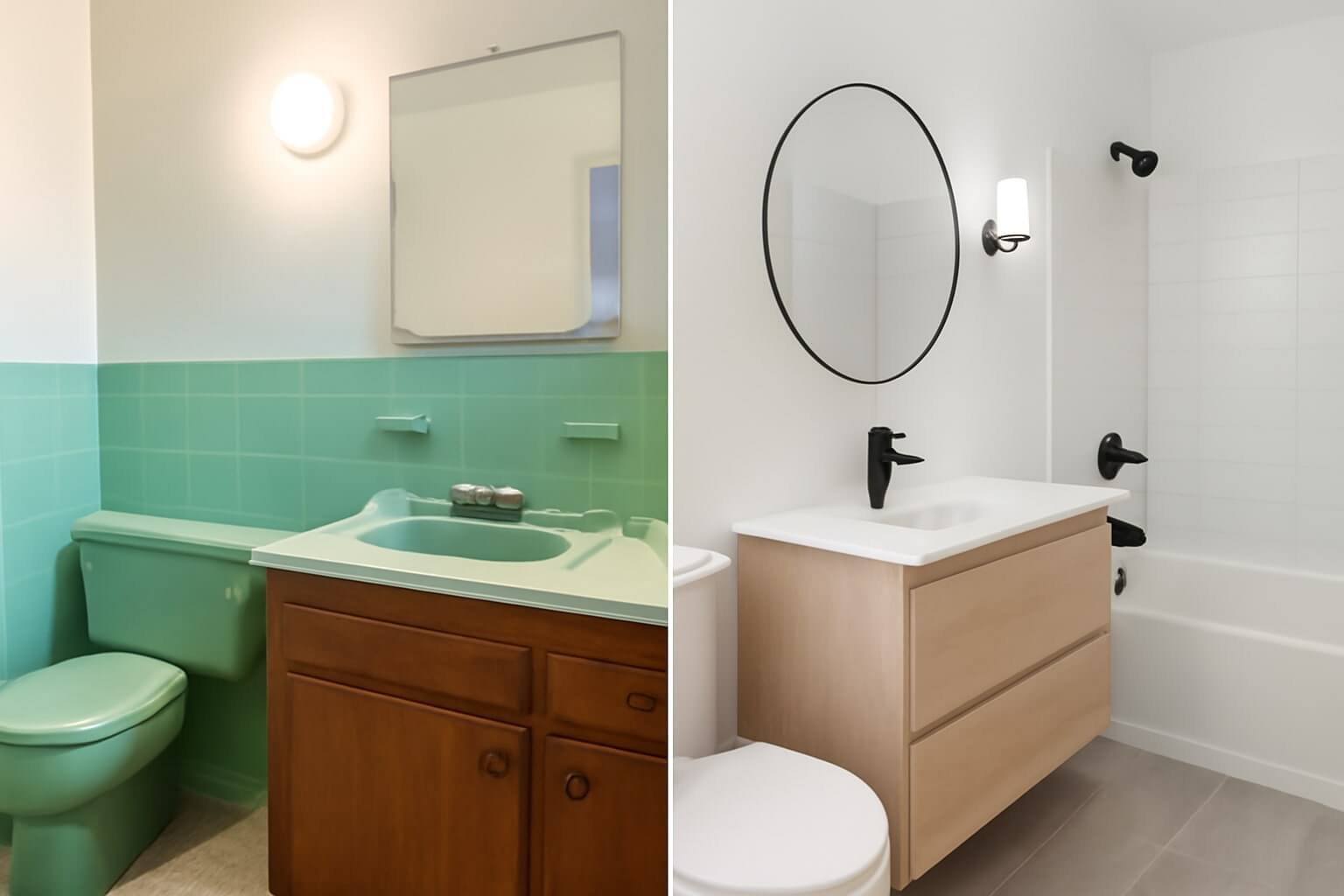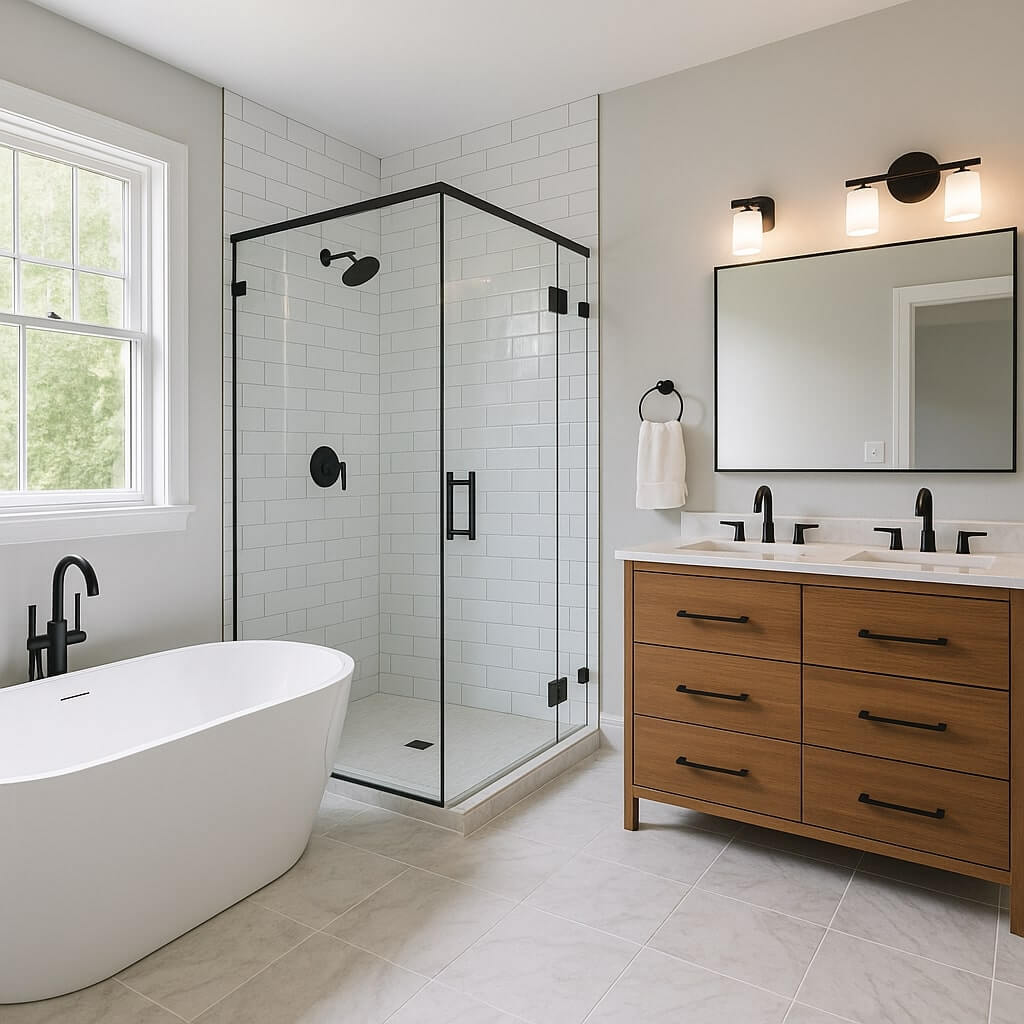When you’re planning a one-day bathroom remodel, calculating costs is vital. Start by evaluating the current condition of your space and setting a realistic budget. From there, you’ll need to choose materials and fixtures wisely while estimating labor costs. Don’t forget to set aside funds for unexpected expenses. Understanding these elements can help streamline your project, but there’s more to take into account as you move forward. Let’s explore how to get it all right.
Key Takeaways
- Assess the scope of work for the remodel to determine necessary materials and labor costs.
- Create a detailed budget breakdown, including costs for fixtures, materials, and labor.
- Research local averages for remodeling costs to guide your budget expectations.
- Allocate an additional 10-20% of the budget to cover unexpected expenses and surprises.
- Decide between DIY and hiring professionals based on your skills, budget, and project complexity.
Assessing Your Bathroom’s Current Condition
Before diving into a bathroom remodel, it’s essential to assess your bathroom’s current condition to identify what needs updating.
Start with a bathroom functionality assessment—check for leaks, water pressure issues, and outdated fixtures. Pinpoint areas that hinder daily use.
Next, consider aesthetic improvement considerations; evaluate the color scheme, tiles, and lighting. Take note of any worn-out elements that could benefit from a fresh look.
By thoroughly analyzing both functionality and aesthetics, you’ll make informed decisions that enhance your bathroom’s overall appeal while ensuring it meets your practical needs.
This foundation will guide your remodeling journey effectively.
Setting a Realistic Budget
Once you’ve assessed your bathroom’s condition, it’s time to set a realistic budget for your remodel.
Start by using effective budgeting strategies, like determining your overall budget limit and allocating funds for each area. Create a cost breakdown that includes labor, materials, and unexpected expenses.
Remember to prioritize essential updates over aesthetic changes, ensuring you stay focused on your goals. Research average costs in your area to avoid overspending.
Choosing Materials and Fixtures
As you immerse yourself in the process of choosing materials and fixtures for your bathroom remodel, keep in mind that these selections greatly impact both the functionality and aesthetic appeal of the space.
Prioritize material durability, ensuring that surfaces can withstand moisture and everyday wear. For flooring, consider options like ceramic tiles or vinyl, which offer both style and longevity.
When selecting fixture styles, think about the overall look you want to achieve—modern, vintage, or minimalist.
Balancing quality and design will enhance your bathroom’s appeal while ensuring practicality for years to come. Choose wisely for a transformation you’ll love.
Estimating Labor Costs
While it might be tempting to focus solely on materials and fixtures, estimating labor costs is equally essential when budgeting for your bathroom remodel. Understanding labor rates in your area will help you accurately forecast your expenses.
Be sure to take into account the project timeline, as longer projects usually incur higher costs. Here are some key factors to factor in:
- Type of labor required (contractor vs. handyman)
- Experience level of the workers
- Complexity of the remodel
- Local market conditions
- Estimated hours needed for completion
Planning for Unexpected Expenses
When remodeling your bathroom, it’s essential to plan for unexpected expenses that can pop up along the way.
Hidden costs, like plumbing issues or outdated electrical systems, can quickly derail your budget.
Setting aside an emergency fund can help you stay on track and avoid stress during the renovation process.
Anticipating Hidden Costs
Hidden costs can sneak up on you during a bathroom remodel, making it essential to plan for unexpected expenses.
You might encounter hidden expenses that can lead to potential overruns if you’re not careful. Here are some common pitfalls to take into account:
- Unforeseen plumbing issues
- Outdated electrical wiring
- Mold or water damage
- Changes in design or materials
- Permit fees or inspections
Emergency Fund Allocation
To guarantee your bathroom remodel goes smoothly, it’s important to allocate an emergency fund for unexpected expenses.
Setting aside some emergency savings can provide you with a financial cushion, ensuring you’re prepared for anything from plumbing issues to material shortages.
Aim to reserve about 10-20% of your total budget for these surprises. This way, you won’t feel stressed or rushed to make decisions if something unexpected pops up.
Comparing DIY vs. Hiring Professionals
Whether you’re a seasoned DIYer or considering hiring professionals, understanding the differences between the two approaches is crucial for your bathroom remodel.
DIY Advantages:
- Cost savings on labor
- Flexibility in scheduling
- Personalized design choices
- Sense of accomplishment
- Opportunity to learn new skills
However, hiring professionals brings their own benefits. Their professional expertise guarantees quality workmanship, adherence to timelines, and compliance with local standards.
Weighing these factors will help you decide what’s best for your project and budget. Ultimately, the choice between DIY and hiring pros hinges on your skills, time, and the complexity of your remodel.
Understanding Permits and Regulations
When remodeling your bathroom, understanding local building codes is essential to avoid costly mistakes.
You’ll need to navigate the permit application process and be aware of any inspection requirements that may arise.
Local Building Codes
Understanding local building codes is essential for a successful bathroom remodel, as they dictate what’s permissible in your project.
These codes guarantee compliance requirements and adherence to safety standards, protecting both you and your home.
- Check for necessary permits before starting.
- Know the maximum allowable water usage for fixtures.
- Ascertain electrical work meets local safety standards.
- Verify plumbing installations follow code regulations.
- Familiarize yourself with ventilation requirements.
Permit Application Process
Before diving into your bathroom remodel, it’s crucial to navigate the permit application process, as obtaining the right permits is often a key step that guarantees your project complies with local regulations.
Start by researching the various permit types required for your remodel, which may include electrical, plumbing, or structural permits. Check with your local building office for specifics.
The application timeline can vary, so submit your requests early to avoid delays. By proactively addressing permits, you’ll facilitate a smoother remodel experience and avoid potential fines or project setbacks.
Stay informed, and your bathroom transformation will be hassle-free!
Inspection Requirements Explained
While you might be enthusiastic to start your bathroom remodel, it’s essential to grasp the inspection requirements that accompany your permits.
Understanding these requirements will guarantee you’re meeting local regulations and avoiding costly delays.
Follow this compliance checklist to stay on track:
- Know the inspection criteria specific to your project.
- Schedule inspections at key project milestones.
- Keep all relevant documents readily available.
- Communicate with your inspector about any changes.
- Address any issues promptly to avoid re-inspection.
Calculating the Total Cost
To accurately calculate the total cost of your bathroom remodel, you’ll need to take into account several key factors that contribute to the overall budget.
Start by creating a detailed cost breakdown, listing materials, labor, and any unexpected expenses. Don’t forget to include permits and tools if necessary.
Keeping track of your expenses is essential; use a spreadsheet or an app for effective expense tracking. This way, you can monitor your spending and adjust your plans if something exceeds your budget.
Tips for Staying Within Budget
Staying within budget during your bathroom remodel can feel challenging, but with the right strategies, it’s entirely achievable.
Here are some tips to help you find budget-friendly options and implement cost-saving strategies:
- Prioritize essential upgrades over luxury items
- Shop sales and clearance sections for materials
- Consider DIY for non-structural tasks
- Set a strict budget and track expenses regularly
- Use versatile, multi-functional fixtures
Conclusion
In just one day, you can transform your bathroom without breaking the bank. By evaluating your current space, setting a realistic budget, and choosing the right materials, you’ll be well on your way to a successful remodel. Don’t forget to factor in labor costs and unexpected expenses to avoid surprises. Whether you decide to go DIY or hire professionals, staying organized and informed will help you create the bathroom of your dreams within your budget. Happy remodeling!




